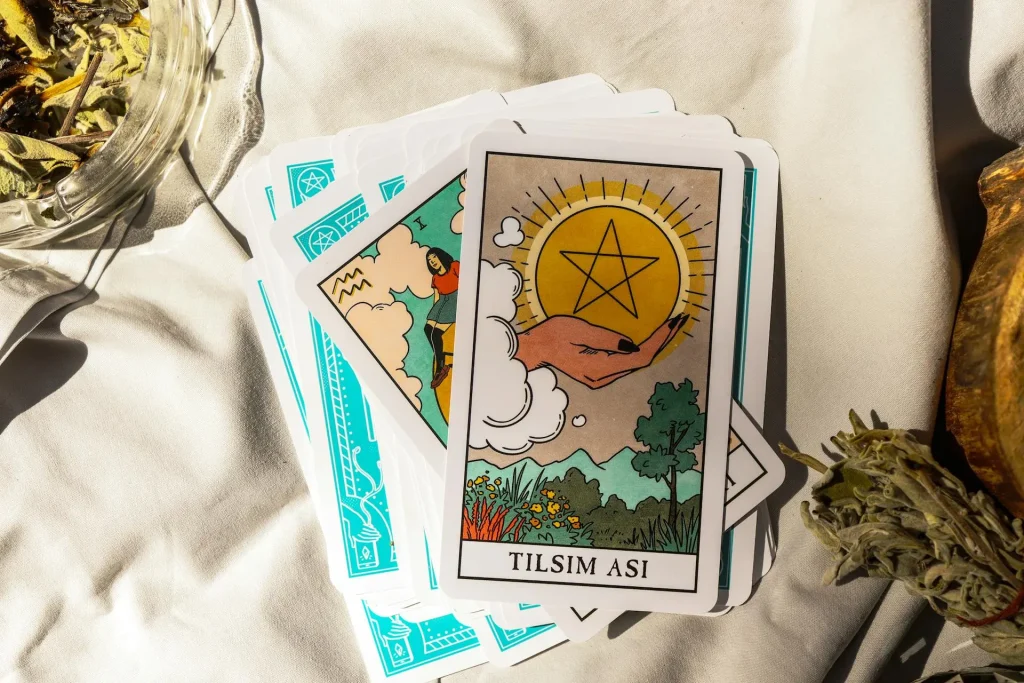The pentagram, a five-pointed star, is one of the most recognizable symbols worldwide. Throughout centuries, it has carried a variety of meanings and applications across different cultures, religions, and spiritual practices.
In this blog post, we’ll dive deeper into the history and different interpretations of the pentagram, and also explore its continuing relevance.
Let’s start!

Photo by dilara irem
Table of Contents
The Origins of the Pentagram
The symbol dates back to as early as 3000 BCE, with the Sumerians and Babylonians among the first known to use it. In these early societies, the five-pointed star represented cosmic order and was often used in religious artifacts. Over time, the symbol spread and took on different meanings in various cultures.
In Ancient Greece, it symbolized health and knowledge. The philosopher Pythagoras, renowned for his mathematical contributions, used it to represent the perfection of the human body, with each point representing a different element: earth, water, fire, air, and spirit. The symbol was also considered as a blueprint for cosmic order, with its angles and proportions reflecting fundamental patterns of life.
In Ancient Egypt, the pentagram was used in connection with the goddess Isis, signifying the protection and the renewal.
In early Christianity, it represented the five wounds of Christ, symbolizing sacrifice and divine protection, as well as the five senses, suggesting the perfection of creation. Over time, Christianity’s association with the pentagram faded.
The Pentagram in Occult, Pagan and Other Traditions
By the Middle Ages, it was adopted by occultists and became a central symbol in various mystical traditions. In alchemy, it represented the concept of quintessence, or the fifth element (spirit), believed to be the force binding the elements of earth, air, fire, and water. This is what gave the pentagram its association with balance between material and spiritual realms.
In modern pagan practices, especially Wicca, it represents the previously mentioned five elements, and the unity of these forces. It’s often seen as a protective symbol and is worn as a talisman to ward off negative energies.
In other magical traditions, practicioners have also been using it as a protective symbol, believing it can repel evil and provide spiritual protection. It’s often inscribed on objects, drawn in ritual spaces, or worn as jewelry to invoke its shielding powers…

Image by OpenClipart-Vectors from Pixabay
Upright vs. Inverted Pentagrams
The orientation of the symbol has historically impacted its interpretation. With one point facing upward, it traditionally represents spirit above matter, symbolizing balance and the pursuit of enlightenment. This form is commonly used in Wicca and other spiritual traditions as a positive emblem.
In contrast, the inverted pentagram, with two points facing upward, gained associations with Satanism in the 20th century. For some, the inverted form is seen as a subversion of spiritual order, representing materialism over spiritual values.
Mathematics and Geometry of the Pentagram
As a mathematically significant shape, it’s notable for its relation to the golden ratio (which is approximately 1.618). This ratio is found in many aspects of nature, from the spiral of seashells to the proportions of the human body.
The geometry of the pentagram is thought to represent the ultimate harmony, order, and aesthetic beauty.
Modern Interpretations of the Pentagram
The symbol’s meaning has diversified even further, influencing popular culture, art, spirituality and personal views. Its edgy aesthetic and connection to the occult made it a popular emblem in rock and metal music, often used as a symbol of rebellion.
For many people, the pentagram is a sign of personal empowerment or some personal beliefs (that may be considered as an alternative / non-mainstream ones). It serves as a reminder of the connection to the nature and spirituality; representing a holistic view of life, honoring both material and spiritual needs.
However, misunderstandings about the pentagram also exist. The association of the inverted version with Satanism, previously mentioned in this blog post, has led to widespread misconceptions about the pentagram meaning, with many people viewing it solely as an evil symbol (and, yeah, nothing else than that). Media’s portrayals of it as a dark symbol have further cemented these misconceptions, particularly due to the horror and supernatural movies and other outlets.
___________
Now, what’s your opinion on it?
Looking forward to your comments below!
___________
More Articles
- The Moon Phases: History, Science, Symbolism, and Spiritual Practices
- Crystal Ball: A Comprehensive Guide to the Mystical Sphere
